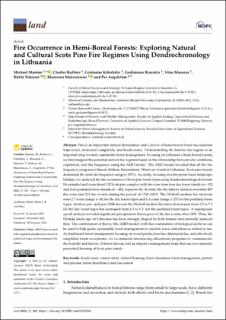| dc.description.abstract | Fire is an important natural disturbance and a driver of hemi-boreal forest successional trajectories, structural complexity, and biodiversity. Understanding the historic fire regime is an important step towards sustainable forest management. Focusing on Lithuania’s hemi-boreal forests, we first mapped the potential natural fire regimes based on the relationship between site conditions, vegetation, and fire frequency using the ASIO model. The ASIO model revealed that all the fire frequency categories (Absent, Seldom, Intermittent, Often) are found in Lithuania. Scots pine forests dominated the often fire frequency category (92%). Secondly, focusing on a fire-prone forest landscape, Dzukija, we analyzed the fire occurrence of Scots pine forest types using dendrochronological records. We sampled and cross-dated 132 Scots pine samples with fire scars from four dry forest stands (n = 92) and four peatland forest stands (n = 40), respectively. In total, the fire history analysis revealed 455 fire scars and 213 fire events during the period of 1742–2019. The Weibull median fire intervals were 2.7 years (range 1–34) for the dry forest types and 6.3 years (range 1–27) for the peatland forest types. Analysis pre- and post-1950 showed the Weibull median fire interval increased from 2.2 to 7.2 for the dry forest types but decreased from 6.2 to 5.2. for the peatland forest types. A superposed epoch analysis revealed significant precipitation fluxes prior to the fire events after 1950. Thus, the Dzukija landscape of Lithuania has been strongly shaped by both human and naturally induced fires. The combination of theory (the ASIO model) with the examination of biological archives can be used to help guide sustainable forest management to emulate forest disturbances related to fire. As traditional forest management focusing on wood production has eliminated fire, and effectively simplified forest ecosystems, we recommend introducing educational programs to communicate the benefits and history of forest fires as well as adaptive management trials that use low-intensity prescribed burning of Scots pine stands. | en_US |

